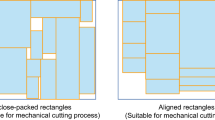Abstract
The cutting-stock problem, which considers how to arrange the component profiles on the material without overlaps, can increase the utility rate of the sheet stock. It is thus a standard constrained optimization problem. In some applications the components should be placed with specific orientations, but in others the components may be placed with any orientation. In general, the methods used to solve the cutting-stock problem usually have global search strategies to improve the solution, such as the Genetic Algorithm and the Simulated Annealing Algorithm. Unfortunately, many parameters, such as the temperature and the cooling rate of the Simulated Annealing method and the mutation rate of the Genetic Algorithm, have to be set and different settings of these parameters will strongly affect the result. This study formulates the cutting-stock problem as an optimization problem and solves it by the SQP method. The proposed method will make it easy to consider different orientations of components. This study also presents a global search strategy for which the parameter setting is easy.
Similar content being viewed by others
References
Arora J.S. (1984) An algorithm for optimum structural design without line search. In: Atrek E., Gallagher R.H., Ragsdell K.M., Zienklewiz O.C. (eds) New directions in optimum structural design (Chap. 20). John Wiley and Sons, New York
Arora J. S. (1988) IDESIGN software, optimal design laboratory, college of engineering. The University of Iowa, Iowa City
Arora J. S. (2004) Introduction to optimum design (2nd ed.). Elsevier/Academic Press, London
Bennell J. A., Dowsland K. A. (1999) A tabu thresholding implementation for the irregular stock cutting problem. International Journal of Production Research 37(18): 4259–4275
Bennell J. A., Dowsland K. A. (2001) Hybridising tabu search with optimisation techniques for irregular stock cutting. Management Science 47(8): 1160–1172
Dowsland K. A., Vaid S., Dowsland W. B. (2002) An algorithm for polygon placement using a bottom-left strategy. European Journal of Operational Research 141: 371–381
ESICUP website (http://paginas.fe.up.pt~esicup/tiki-index.php).
Gomes A. M., Oliveira J. F. (2002) A 2-exchange heuristic for nesting problems. European Journal of Operational Research 141: 359–370
Leung T. W., Chan C. K., Troutt M. D. (2003) Application of a mixed simulated annealing-genetic algorithm heuristic for the two-dimensional orthogonal packing problem. European Journal of Operational Research 145: 530–542
Liao, W. C. (1990). Integrated software for multifunctional optimization. Master Thesis, National Chiao Tung University, Taiwan, ROC.
Marques, V. M. M., Bispo, C. F. G., & Sentieiro, J. J. S. (1991). A system for the compactation of two-dimensional irregular shapes based on simulated annealing. In Proceedings of the 1991 International Conference on Industrial Electronics, Control and Instrumentation-IECON (Vol. 91, pp. 1911–1916).
Onwubolu G. C., Mutingi M. (2003) A genetic algorithm approach for the cutting stock problem. Journal of Intelligent Manufacturing 14(2): 209–218
Petridis, V., & Kazarlis, S. (1994). Varying quality function in genetic algorithms and the cutting problem. In Proceedings of the IEEE Conference on Evolutionary Computation (pp. 166–169)
Poshyanonda P., Dagli C. H. (2004) Genetic neuro-nester. Journal of Intelligent Manufacturing 15(2): 201–218
Ratanapan K., Dagli C. H., Grasman S. E. (2007) An object-based evolutionary algorithm for solving nesting programs. International Journal of Production Research 45(4): 845–869
Stoyan Y. G., Terno J., Scheithauer G., Gil N., Romanova T. (2001) Φ-functions for primary 2D-objects. Studia informatica universalis. International Journal on Informatics 2(1): 1–32
Szykman S., Cagan J. (1995) A simulated annealing-based approach to three dimensional component packing. Transactions of the ASME 117: 308–314
Tseng, C. H. (1989). MOST software, Applied Optimal Design Laboratory, Department of Mechanical Engineering, The National Chiao-Tung University, Taiwan, ROC.
Yu M. T., Lin T. Y., Hung C. (2009) Active-set sequential quadratic programming method for the multi-polygon mass production cutting-stock problem with rotatable polygons. International Journal of Production Economics 121: 148–161
Author information
Authors and Affiliations
Corresponding author
Rights and permissions
About this article
Cite this article
Yu, M.T., Lin, T.Y. & Hung, C. Sequential quadratic programming method with a global search strategy on the cutting-stock problem with rotatable polygons. J Intell Manuf 23, 787–795 (2012). https://doi.org/10.1007/s10845-010-0433-0
Received:
Accepted:
Published:
Issue Date:
DOI: https://doi.org/10.1007/s10845-010-0433-0



